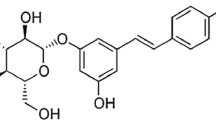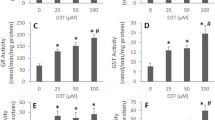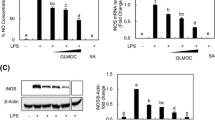Abstract
Objective
This study tested whether FC-77, a perfluorochemical, inhibits inflammatory responses in lipopolysaccharide (LPS) stimulated RAW 264.7 macrophages. The possible anti-inflammatory mechanisms involved were also investigated.
Methods
RAW 264.7 macrophages were simultaneously incubated with pure FC-77 at final volume of 10% or 30% (v/v) and LPS (1 µg/ml) for 12 or 24 h on a mechanical shaker. In some tests FC-77 was added after cells stimulated by LPS for 12 h. Then the levels of prostaglandin E2 (PGE2), tumor necrosis factor α (TNF-α), and interleukins (IL)-1β, -6), and -10 were measured in medium. Alterations in cyclooxygenase (COX) 2 expression and nuclear transcription factor (NF) κB activation in cells were also evaluated.
Results
Pre- or posttreatment with FC-77 dose-dependently reduced the LPS-induced TNF-α, IL-1β, and IL-6 formation and enhanced IL-10 production compared to LPS-stimulated alone cells. FC-77 also attenuated the LPS-induced PGE2 formation accompanied by suppressing COX-2 expression, the degradation of cytosolic inhibitor of κB-α and NF-κB activation.
Conclusions
FC-77 inhibits inflammatory responses in LPS-stimulated macrophages by a mechanism that involves the attenuation of NF-κB dependent induction of COX-2/PGE2 pathway and the pro- /anti-inflammatory cytokine ratio.
Similar content being viewed by others
Avoid common mistakes on your manuscript.
Introduction
Many studies have reported that partial liquid ventilation with perfluorochemical (PFC) improves gas exchange and pulmonary function in several models of lung injury [1, 2]. Using perflubron, a type of PFC, in partial liquid ventilation could reduce the inflammatory responses of trauma patients [3]. In addition, perflubron also suppresses the production of reactive oxygen species (ROS) [4] and malondialdehyde, an indication of lipid peroxidation, as well as pro-inflammatory cytokines [5, 6], suggesting that perflubron exerts an anti-inflammatory effect. However, perflubron is not available worldwide. FC-77, another type of PFC, has relatively higher vapor pressure and lower viscosity and less radiodensity than perflubron. Theoretically FC-77 may evaporate from the lungs faster than perflubron after finishing liquid ventilation, which may be beneficial for faster recovery after liquid assisted ventilation [7]. However, whether FC-77 has an anti-inflammatory effect is still unknown.
Overproduction of prostaglandin E2 (PGE2) derived from inducible cyclooxygenase (COX) 2 induced by lipopolysaccharide (LPS) and/or proinflammatory cytokines has been implicated in the pathogenesis of inflammatory diseases [8, 9]. Elevated proinflammatory cytokine release by alveolar macrophages seems to be correlated with poor outcome in patients with acute respiratory disease syndrome [10], suggesting that activated macrophages are a major source of inflammatory mediators. The present study examined whether the anti-inflammatory activity of FC-77 is associated with the suppression of COX-2/PGE2 pathway and cytokine formation in LPS-stimulated RAW 264.7 macrophages. In addition, the possible molecular mechanisms involved were also investigated.
Materials and methods
Reagents
The FC-77 (chemical formula: C8F18, with a purity 100%) was purchased from 3M company (St. Paul, Minn., USA). Antibodies of COX-2 and IκB-α (Transduction Lab., Lexington, Ky., USA) as well as α-tubulin antibody (Santa Cruz, San Francisco, Calif., USA) were used in this study. Enzyme-linked immunosorbent assay kits including PGE2, tumor necrosis factor (TNF) α, interleukin (IL) 6, IL-1β, and IL-10 were purchased from Biosource International (Camarillo, Calif., USA). Escherichia coli derived LPS (E. coli serotype 055:B5) was purchased from Sigma Chemical (St. Louis, Mo., USA).
Cell culture
To prepare the tested solution of FC-77 (10% and 30%, v/v) pure FC-77 (100%) was mixed with Dulbecco’s modified Eagle’s medium (DMEM; v/v=1:9 or 3:7, respectively). Macrophages (1×106 cells) were cultured in 24-well plates with a total volume of 600 µl FC-77 tested solution (10% or 30%, v/v) per well in the presence or absence of LPS (1 µg/ml). As FC-77 is not miscible with the medium, cells incubated with FC-77 were shaken by using a mechanical shaker with gently agitation at 60 rpm [6]. After incubation for 12 or 24 h the medium was collected and centrifuged to obtain the FC-77 free supernatants for the following PGE2 and cytokine assays, and cells washed twice with PBS buffer to remove residual FC-77 were collected for western blot assay. To further evaluate whether FC-77 has a therapeutic effect, after cells stimulated with LPS (1 µg/ml) for 12 h, fresh medium containing FC-77 (10% or 30%, v/v) and cycloheximide (4 µM) was added and the PGE2 and cytokine levels of medium were measured after a further 12 h incubation. The cells cultured with DMEM alone acted as control group.
Western blot analysis of COX-2
The COX-2 western blotting assay of cells was determined according to our previously described method [11]. Expression of COX-2 protein was detected by enhanced chemiluminescence reagent (Amersham, Buckinghamshire, UK) and quantified by densitometry and normalized with respect to α-tubulin using Image-pro plus software.
IκB-α western blotting
After incubation with LPS for 1 h in the presence or absence of FC-77 the protein of cells was extracted and separated on 10% sodium dodecylsulfate polyacrylamide gels and then transferred to polyvinylidene difluoride membranes (Millipore, Bedford, Mass., USA). Membranes incubated with 5% (w/v) skim milk, the inhibitor (I) of κB-α and anti-α-tubulin antibody were then added. The relative protein expression was quantified by densitometry as described above.
NF-κB activation assay
After incubation with LPS for 1 h in the presence or absence of FC-77 the nuclear protein fractions of cells were separated. Then nuclear transcription factor (NF) κB kit (BD Biosciences Clontech, Palo Alto, Calif., USA) was used to determine the activation of NF-κB.
Cell viability assay
Cell respiration, an indicator of cell viability, assessed by the mitochondrial dependent reduction of 3-(4, 5-dimethylthiazol-2-yl)-diphenyltetrazolium bromide to formazan, was quantified spectrophotometrically by measurement at OD550.
Statistical analysis
Data are expressed as means ±SEM. All results were analyzed by one-way analysis of variance followed by a multiple comparison test (Scheffe’s test). A p value less than 0.05 was considered statistically significant.
Results
FC-77 (10% or 30%, v/v) added simultaneously with LPS for 12 or 24 h (Fig. 1A) or added into cells stimulated by LPS for 12 h (Fig. 1B) resulted in a dose-dependent inhibition in the LPS-induced PGE2 production compared to that of LPS-stimulated alone cells.
Effect of FC-77 on PGE2 production in LPS-stimulated RAW 264.7 macrophages. After incubation of FC-77 with cells in response to LPS (1 µg/ml) for 12 or 24 h the PGE2 levels in the medium were measured (A). After cells were stimulated with LPS (1 µg/ml) for 12 h, fresh medium containing FC-77 and cycloheximide (4 µM) was added, and the levels of PGE2 in medium were measured after a further 12 h incubation (B). The cells cultured with DMEM alone acted as control group. Values of each group are expressed as mean ±SEM (n=6, each group). *p<0.05, **p<0.01, ***p<0.001 vs. respective LPS-stimulated alone cells
Incubation with FC-77 for 24 h significantly inhibited the LPS-induced COX-2 protein expression (Fig. 2) compared to that of LPS-stimulated alone cells.
Effect of FC-77 on COX-2 protein expression in LPS-stimulated RAW 264.7 macrophages. After incubation of FC-77 with cells in response to LPS (1 µg/ml) for 24 h the cells were collected for COX-2 protein assay. The cells cultured with DMEM alone acted as control group. Western blotting is representative of five similar experiments. Values of each group are expressed as mean ±SEM. **p<0.01, ***p<0.001 vs. LPS-stimulated alone cells
FC-77 added simultaneously with LPS for 12 or 24 h (Fig. 3) or added into cells stimulated by LPS for 12 h (Fig. 4) caused a dose-dependent inhibition in TNF-α, IL-1β, and IL-6 formation but markedly enhanced the IL-10 formation compared to that of LPS-stimulated alone cells.
Effect of simultaneous treatment with FC-77 on TNF-α, IL-1β, IL-6, and IL-10 production in LPS-stimulated RAW 264.7 macrophages. After incubation of cells with LPS for 12 or 24 h in the presence or absence of FC-77 the concentrations of TNF-α, IL-1β, IL-6, and IL-10 in the medium were measured. The cells cultured with DMEM alone acted as control group. Values of each group are expressed as mean ±SEM (n=6, each group). *p<0.05, **p<0.01, ***p<0.001 vs. respective LPS-stimulated alone cells
Effect of posttreatment with FC-77 on TNF-α, IL-1β, IL-6, and IL-10 production in LPS-stimulated RAW 264.7 macrophages. After cells were stimulated with LPS (1 µg/ml) for 12 h, fresh medium containing FC-77 and cycloheximide (4 µM) was added, and the levels of TNF-α, IL-1β, IL-6, and IL-10 in medium were measured after a further 12-h incubation. The cells cultured with DMEM alone acted as control group. Values of each group are expressed as mean ±SEM (n=6, each group). *p<0.05, **p<0.01, ***p<0.001 vs. LPS-stimulated alone cells
Treatment with LPS for 1 h resulted in a marked degradation of cytosolic IκB-α. FC-77 added simultaneously with LPS for 1 h prevented the cytosolic IκB-α degradation compared to that of LPS-stimulated alone cells (Fig. 5).
Effect of FC-77 on the cytosolic IκB-α degradation in LPS-stimulated RAW 264.7 macrophages. After incubation with LPS for 1 h in the presence or absence of FC-77 the cytosolic protein of cells was collected for IκB-α protein assay by western blotting. Western blotting is representative of five similar experiments. The cells cultured with DMEM alone acted as control group. Values of each group are expressed as mean ±SEM (n=5, each group). *p<0.05, ***p<0.001 vs. LPS-stimulated alone cells; #p<0.01, ##p<0.001 vs. control cells
When cells were treated with FC-77 for 1 h, the LPS-induced formation of p50 and p65 NF-κB specific DNA-protein complex in nuclear extracts was dose-dependently inhibited (Fig. 6). In unstimulated cells FC-77 itself did not affect these mediators tested, including the basal PGE2 and cytokines formation as well as COX-2, IκB-α protein expression, and the activation of NF-κB (data not shown).
Effect of FC-77 on nuclear NF-κB activation in LPS-stimulated RAW 264.7 macrophages. After incubation with LPS for 1 h in the presence or absence of FC-77 the nuclear extracts were prepared for assaying the formation of p50 and p65 NF-κB specific DNA-protein complex by enzyme-linked immunosorbent assay. The cells cultured with DMEM alone acted as control group. Values of each group are expressed as mean ±SEM (n=5, each group). *p<0.05, **p<0.01 vs. LPS-stimulated alone cells; #p<0.01, ##p<0.001 vs. control cells
FC-77 did not significantly diminish cell respiration at the solution studied (10% or 30%, v/v), with cell viability more than 95% of controls.
Discussion
Proinflammatory cytokines including TNF-α, IL-6, IL-1β, and TNF-α increase greatly after exposure to LPS, which in turn induces COX-2 expression [12]. Thus inhibition of these proinflammatory cytokines formation by FC-77 may account for the reduction in COX-2/PGE2 pathway. Although we found that FC-77 inhibits IL-6 formation, the mechanisms involved are not well understood. Previous studies have reported that the effects of PGE2 on IL-6 and TNF-α formation are contrary, inducing IL-6 formation but inhibiting TNF-α production [13, 14]. Recent study further demonstrated that treatment of anti-TNF antibody abolishes the LPS-induced IL-6 production in vitro and in vivo while PGE2 does not contribute significantly to LPS-induced IL-6 generation [15]. Accordingly, we proposed that FC-77 inhibited LPS-induced IL-6 formation is mainly secondary to the suppression of TNF-α synthesis. Under inflammatory conditions enhanced ROS formation may cause the release of TNF-α and induction of COX-2, and treatment with antioxidants reverses these inductions [16]. Our unpublished data show that FC-77 dose-dependently inhibits the LPS-induced hydrogen peroxide formation in RAW264.7 macrophages. Therefore the antioxidant activity of FC-77 may at least in part contribute to the inhibition in proinflammatory cytokines formation.
A novel finding in this study was that PC-77 also increases the production of IL-10, which differs from the effect of perflubron [3]. IL-10 is a pleiotropic cytokine that controls inflammatory process by suppressing the production of proinflammatory cytokines, ROS, and PGE2 formation [17, 18, 19]. However, PGE2 also can induce IL-10 release in macrophages [20]. Furthermore, administration of antioxidant or inhibitor of nitric oxide synthase (NOS) decreases the LPS-induced TNF-α and IL-1β generation but enhances IL-10 formation [21, 22], suggesting that the regulation of IL-10 is very complex. Our preliminary data demonstrate that FC-77 significantly inhibits NO formation by suppressing inducible NOS expression in LPS-stimulated RAW264.7 macrophages. Thus the attenuation of ROS and NO production by FC-77 may contribute to the enhancement of IL-10 formation, which in turn leads to a decrease in the proinflammatory/anti-inflammatory cytokine ratio. Furthermore, pre- or posttreatment with FC-77 inhibited LPS-induced PGE2 and proinflammatory cytokine formation but increased IL-10 production, indicating that FC-77 may be a potential preventive and therapeutic agent for inflammatory diseases.
To further investigate the molecular mechanism involved we evaluated the alteration in NF-κB activation. NF-κB, a p50/p65 heterodimer, is a key nuclear transcription factor for regulating induction of COX-2 and proinflammatory cytokines [23]. Once activated by LPS, the IκB-α/NF-κB complex in cytoplasm is dissociated, causing the translocation of NF-κB into nucleus and in turn activating gene transcription. Our results indicate that the activation of NF-κB is inhibited by FC-77 by preventing the degradation of IκB-α in cytoplasm, which is similar to that of perflubron [24]. Other possible mechanisms reported by previous studies, such as a reduction in phagocyte function due to modification of cell membrane receptor-ligand binding [4] or altered membrane fluidity [25] by PFCs, may be also involved in the anti-inflammatory activity of FC-77.
In conclusion, we provide a novel mechanism to explain the anti-inflammatory activity of FC-77 by suppressing COX-2/PGE2 pathway, which may be associated with the attenuation of proinflammatory/anti-inflammatory cytokine ratio and NF-κB activation in LPS-stimulated RAW 264.7 macrophages.
References
Hirschl RB, Tooley R, Parent AC, Johnson K, Barlett RH (1995) Improvement of gas exchange, pulmonary function, and lung injury with partial liquid ventilation. Chest 108:500–508
Hirschl RB, Tooley R, Parent AC, Johnson K, Barlett RH (1996) Evaluation of gas exchange, pulmonary compliance, and lung injury during total and partial liquid ventilation in the acute respiratory distress syndrome. Crit Care Med 21:1270–1278
Croce MA, Fabian TC, Patton JH Jr, Melton SM, Moore M, Trenthem LL (1998) Partial liquid ventilation decreases the inflammatory response in the alveolar environment of trauma patients. J Trauma 45:273–280
Smith TM, Steinhorn DM, Thusu K, Fuhrman BP, Dandona P (1995) A liquid perfluorochemical decreases the in vitro production of reactive oxygen species by alveolar macrophages. Crit Care Med 23:1533–1539
Rotta AT, Gunnarsson B, Hernan LJ, Fuhrman BP, Steinhorn DM (2000) Partial liquid ventilation with perflubron attenuates in vivo oxidative damage to proteins and lipids. Crit Care Med 28:202–208
Thomassen MJ, Buhrow LT, Wiedemann HP (1997) Perflubron decreases inflammatory cytokine production by human alveolar macrophages. Crit Care Med 25:2045–2047
Jeng M-J, Kou YR, Sheu C-C, Hwang B (2002) Effects of partial liquid ventilation with FC-77 on acute lung injury in newborn piglets. Pediatr Pulmonol 33:12–21
Strong VE, Mackrell PJ, Concannon EM, Naama HA, Schaefer PA, Shaftan GW, Stapleton PP, Daly JM (2000) Blocking prostaglandin E2 after trauma attenuates pro-inflammatory cytokines and improves survival. Shock 14:374–379
Ejima K, Layne MD, Carvajal IM, Kritek PA, Baron RM, Chen YH, Vom Saal J, Levy BD, Yet SF, Perrella MA (2003) Cyclooxygenase-2-deficient mice are resistant to endotoxin-induced inflammation and death. FASEB J 17:1325–1327
Hyers TM, Tricomi SM, Dettenmeier PA, Fowler AA (1991) Tumor necrosis factor levels in serum and bronchoalveolar lavage fluid of patients with the adult respiratory distress syndrome. Am Rev Respir Dis 144:268–271
ChouTC, Fu E¸ Shen EC (2003) Chitosan inhibits prostaglandin E2 formation and cyclooxygenase-2 induction in lipopolysaccharide-treated RAW 264.7 macrophages. Biochem Biophys Res Commun 308:403–407
Martin-Sanz P, Callejas NA, Casado M, Diaz-Guerra MJ, Bosca L (1998) Expression of cyclooxygenase-2 in foetal rat hepatocytes stimulated with lipopolysaccharide and pro-inflammatory cytokines. Br J Pharmacol 125:1313–1319
Kunkel SL, Spengler M, May MA, Spengler R, Larrick J, Remick D (1988) Prostaglandin E2 regulates macrophage-derived tumor necrosis factor gene expression. J Biol Chem 263:5380–5384
Hinson RM, Williams JA, Shacter E (1996) Elevated interleukin 6 is induced by prostaglandin E2 in a murine model of inflammation: possible role of cyclooxygenase-2. Proc Natl Acad Sci USA 93:4885–4890
Ghezzi P, Sacco S, Agnello D, Marullo A, Caselli G, Bertini R (2000) LPS induces IL-6 in the brain and in serum largely through TNF production. Cytokine 12:1205–1210
Ohgami K, Shiratori K, Kotake S, Nishida T, Mizuki N, Yazawa K, Ohno S (2003) Effects of astaxanthin on lipopolysaccharide-induced inflammation in vitro and in vivo. Invest Ophthalmol Vis Sci 44:2694–2701
Williams L, Bradley L, Smith A, Foxwell B (2004) Signal transducer and activator of transcription 3 is the dominant mediator of the anti-inflammatory effects of IL-10 in human macrophages. J Immunol 172:567–576
Niiro H, Otsuka T, Kuga S, Nemoto Y, Abe M, Hara N, Nakano T, Ogo T, Niho Y (1994) IL-10 inhibits prostaglandin E2 production by lipopolysaccharide-stimulated monocytes. Int Immunol 6:661–664
Dokka S, Shi X, Leonard S, Wang L, Castranova V, Rojanasakul Y (2001) Interleukin-10-mediated inhibition of free radical generation in macrophages. Am J Physiol 280:L1196–L1202
Strassmann G, Patil-Koota V, Finkelman F, Fong M, Kambayashi T (1994) Evidence for the involvement of interleukin 10 in the differential deactivation of murine peritoneal macrophages by prostaglandin E2. J Exp Med 180:2365–2370
Nemeth ZH, Hasko G, Vizi ES (1998) Pyrrolidine dithiocarbamate augments IL-10, inhibits TNF-alpha, MIP-1alpha, IL-12, and nitric oxide production and protects from the lethal effect of endotoxin. Shock 10:49–53
Wu CH, Chen TL, Chen TG, Ho WP, Chiu WT, Chen RM (2003) Nitric oxide modulates pro- and anti-inflammatory cytokines in lipopolysaccharide-activated macrophages. J Trauma 55:540–545
Zamamiri-Davis F, Lu Y, Thompson JT, Prabhu KS, Raddy PV, Sordillo LM, Reddy CC (2002) Nuclear factor-kappaB mediates over-expression of cyclooxygenase-2 during activation of RAW 264.7 macrophages in selenium deficiency. Free Radic Biol Med 32:890–897
Haeberle HA, Nesti F, Dieterich H-J, Gatalica Z, Garofalo RP (2002) Perflubron reduces lung inflammation in respiratory syncytial virus infection by inhibiting chemokine expression and nuclear factor-κB activation. Am J Respir Crit Care Med 165:1433–1438
Gause EM, Rowlands JR (1976) Effects of fluorocarbon inhalants upon alveolar macrophages. Proc West Pharmacol Soc 19:373–380
Acknowledgements
The study was partly supported by research grants of the National Science Council of Taiwan and Tao-Yuan Army Hospital, Republic of China.
Author information
Authors and Affiliations
Corresponding author
Rights and permissions
About this article
Cite this article
Chang, H., Kuo, FC., Lai, YS. et al. Inhibition of inflammatory responses by FC-77, a perfluorochemical, in lipopolysaccharide-treated RAW 264.7 macrophages. Intensive Care Med 31, 977–984 (2005). https://doi.org/10.1007/s00134-005-2652-y
Received:
Accepted:
Published:
Issue Date:
DOI: https://doi.org/10.1007/s00134-005-2652-y











